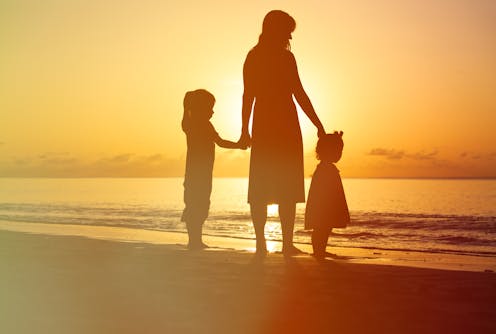The government has released its action plans to end violence against women and children. Will they be enough?
- Written by Kate Fitz-Gibbon, Director, Monash Gender and Family Violence Prevention Centre; Professor of Social Sciences, Faculty of Arts, Monash University

The Australian government has today released the First Action Plan 2023-2027[1] and the Aboriginal and Torres Strait Islander Action Plan[2] under the National Plan to End Violence against Women and Children 2022-2032[3]. These long-awaited plans detail what the Commonwealth, state and territory governments have agreed to do to progress their ambitious target to eliminate domestic, family and sexual violence.
In the first 32 weeks of 2023 alone, 44 women have been killed allegedly by violence. These action plans come at a critical time when advocates, academics and practitioners have been calling for[4] more funding and clearer actions to counter domestic, family and sexual violence.
Read more: A new national plan aims to end violence against women and children 'in one generation'. Can it succeed?[5]
What are the action plans?
The action plans set out the national and state-based commitments across prevention, early intervention, response, recovery and healing.
The purpose of the first action plan[6] is to
understand what actions governments are taking to end gender-based violence, what outcomes the actions and activities aim to achieve, and the targets we are working towards.
The Aboriginal and Torres Strait Islander Action Plan[7] is the first dedicated plan to address violence against women and children in First Nations communities.
It was developed with the Aboriginal and Torres Strait Islander Advisory Council[8] and in consultation with First Nations communities. It provides a road map for addressing the disproportionately high rates of violence First Nations women and children experience.
What commitments have been made?
The first action plan[9] commits to implementing ten actions[10].
It includes education and training across justice, specialist and mainstream workforces, as well as advancing gender equality.
Specific actions outlined in the first action plan include:
funding to support increased education and training on family, domestic and sexual violence for community mainstream workers, health professionals and the justice sector
establishing an Aboriginal and Torres Strait Islander Men’s Advisory Body to provide advice and leadership on issues such as family violence, gender equality, programs and services for men
improving access to short-term, medium-term and long-term housing for women and children experiencing violence
improving actions to prevent and address sexual violence and harassment in all settings
improving police responses and the justice system to better support victim-survivors by providing trauma-informed, culturally safe supports that promote safety and wellbeing. This also includes holding people who choose to use violence to account.
One of the notable features of the national plan[11] is its focus on recovery and healing. The first action plan commits to enhancing trauma-informed supports and exploring new models of recovery for victim-survivors.
The national plan[12] also includes an acknowledgement of children and young people as victim-survivors in their own right.
The first action plan[13] commits to developing and implementing age-appropriate, culturally safe programs across all four domains of prevention, early intervention, response, recovery and healing. These will be informed by children and young people.
While the detail of how this will be achieved is unclear, the commitment is critical. As we have noted previously[14], ending gender-based violence in one generation requires a focus on delivering improved outcomes with transformational results for the next generation.
How will success be measured?
One of the key criticisms[15] of the former national plan[16] was that it didn’t include any measures to track progress over its ten-year life span.
Notably, the evaluation of the former plan was never released publicly. This is a significant failing in public accountability for efforts to reduce violence against women and children.
A key finding from the consultations[17] was the emphasis from stakeholders[18] and victim-survivors[19] that targets be included in this national plan.
The first action plan[20] is accompanied by an outcomes framework[21] that includes targets to reduce violence. It also promises a future measurement plan, to be released in early 2024.
Careful attention and urgency in developing this measurement plan are critical. The six national targets outlined in the first action plan[22] focus on:
- reducing the prevalence of intimate partner homicide
- improving community knowledge of what constitutes domestic, family and sexual violence
- improving community attitudes.
Notably, this action plan[23] specifies a commitment to a 25% annual reduction in female victims of intimate partner homicide. No justification is included for aiming for this specific level of reduction.
The action plan also recognises that attitudinal change is key to eliminating violence. It includes several targets related to shifting community attitudes.
The first action plan[24] commits to annual reporting of progress. This includes tracking the implementation of the actions contained in the two action plans. This will be a much-needed check, and ensures accountability and transparency over the life of both action plans.
Read more: To end gender-based violence in one generation, we must fix how the system responds to children and young people[25]
What is needed now to ensure effective change and a reduction of violence?
These actions plans represent a much-needed next step in realising the objectives of the national plan[26]. Achieving the set targets will require a significant increase in urgency and funding.
This government has made an unprecedented funding commitment of $2.3 billion over the 2022-23 and 2023-24 budgets to address women’s safety and support delivery of these action plans.
While this sounds impressive, it is not commensurate with the scale of the crisis of domestic, family and sexual violence in Australia. Increased funding to accelerate delivery of these action plans is urgently needed.
It is also critical that the reforms and work in this space are not siloed: housing, economic security and childcare are critical aspects of securing women’s safety. This is a whole-of-government project, and must be led in this way.
The way forward must be driven by a commitment to safety and recognising that we need to move urgently on the actions in the plans. They cannot simply be a political tool: they are the result of extensive consultation across Australia involving experts, advocates and victim-survivors.
This work must accelerate now. Each action may not necessarily work. Monitoring is needed to understand what works and for whom.
Agility is also required to ensure efforts can be tailored to maximise the potential for ending domestic, family and sexual violence in one generation.
References
- ^ First Action Plan 2023-2027 (www.dss.gov.au)
- ^ Aboriginal and Torres Strait Islander Action Plan (www.dss.gov.au)
- ^ National Plan to End Violence against Women and Children 2022-2032 (www.dss.gov.au)
- ^ have been calling for (lens.monash.edu)
- ^ A new national plan aims to end violence against women and children 'in one generation'. Can it succeed? (theconversation.com)
- ^ first action plan (www.dss.gov.au)
- ^ Aboriginal and Torres Strait Islander Action Plan (www.dss.gov.au)
- ^ Aboriginal and Torres Strait Islander Advisory Council (www.niaa.gov.au)
- ^ first action plan (www.dss.gov.au)
- ^ ten actions (www.dss.gov.au)
- ^ national plan (www.dss.gov.au)
- ^ national plan (www.dss.gov.au)
- ^ first action plan (www.dss.gov.au)
- ^ As we have noted previously (theconversation.com)
- ^ the key criticisms (www.thesaturdaypaper.com.au)
- ^ national plan (www.dss.gov.au)
- ^ the consultations (bridges.monash.edu)
- ^ from stakeholders (bridges.monash.edu)
- ^ victim-survivors (www.monash.edu)
- ^ first action plan (www.monash.edu)
- ^ outcomes framework (www.dss.gov.au)
- ^ first action plan (www.dss.gov.au)
- ^ action plan (www.monash.edu)
- ^ first action plan (www.dss.gov.au)
- ^ To end gender-based violence in one generation, we must fix how the system responds to children and young people (theconversation.com)
- ^ national plan (www.dss.gov.au)













